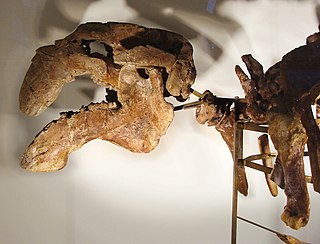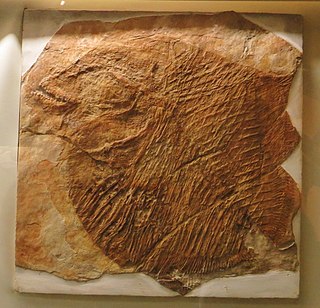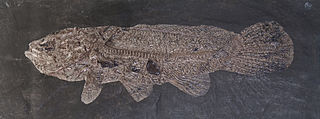Congorhynchus is an enigmatic, likely polyphyletic genus of prehistoric marine ray-finned fish that was described by E. Darteville and E. Casier in 1949.

Gasteroclupea is a genus of prehistoric ellimmichthyiform fish that is distantly related to modern anchovies and herrings. It contains one species, G. branisai. It inhabited freshwater or estuarine habitats across South America during the Campanian and Maastrichtian stages of the Late Cretaceous period, and it briefly survived beyond the K-Pg boundary into the Danian stage of the Paleocene, making it among the few genera from its order to survive into the Cenozoic. Fossils of the genus have been found in the Yacoraite Formation of Argentina, the Chaunaca Formation, Santa Lucía Formation, and El Molino Formation of Bolivia, and the Navay Formation in Venezuela.

Bothremydidae is an extinct family of side-necked turtles (Pleurodira) known from the Cretaceous and Cenozoic. They are closely related to Podocnemididae, and are amongst the most widely distributed pleurodire groups, with their fossils having been found in Africa, India, the Middle East, Europe, North America and South America. Bothremydids were aquatic turtles with a high morphological diversity, indicative of generalist, molluscivorous, piscivorous and possibly herbivorous grazing diets, with some probably capable of suction feeding. Unlike modern pleurodires, which are exclusively freshwater, bothremydids inhabited freshwater, marine and coastal environments. Their marine habits allowed bothremydids to disperse across oceanic barriers into Europe and North America during the early Late Cretaceous (Cenomanian). The youngest records of the group are indeterminate remains from Saudi Arabia and Oman, dating to the Miocene.

Madtsoia is an extinct genus of madtsoiid snakes. It is known from the Eocene of Argentina, the Paleocene of Brazil, the Late Cretaceous (Maastrichtian) of India, and the Late Cretaceous (Maastrichtian) of Madagascar. The type species was the largest with an estimated length of 9–10 m (30–33 ft), and the other three species were smaller. A 5.1 m (17 ft) long M. madagascariensis would have weighed 50 kg (110 lb), but an isolated specimen suggests that this species reached 8 m (26 ft) in maximum length.

Eotheroides is an extinct genus of Eocene sirenian. It is an early member of the family Dugongidae, which includes the extant dugong. Fossils have been found from Egypt, India, and Madagascar. Eotheroides was first described by Richard Owen in 1875 under the name Eotherium, which was replaced by the current name in 1899.

Apateodus is a genus of prehistoric marine ray-finned fish which was described by Woodward in 1901. It was a relative of modern lizardfish and lancetfish in the order Aulopiformes, and one of a number of prominent nektonic aulopiforms of Cretaceous marine ecosystems.

Kushlukia is an extinct genus of prehistoric bony fish, closely related to the luvar, that lived during the lower Eocene. K. permira is from Eocene portion of the Danata Formation Lagerstatten, of Turkmenistan. A second, as yet undescribed species is from the Fuller's Earth formation Lagerstatten in the Barmer District, of Ypresian Rajasthan, India.

Australosomus is an extinct genus of prehistoric ray-finned fish that lived during the Early Triassic epoch in what is now Greenland, Kenya, Tanzania, Madagascar, South Africa and Canada.
Berycomorus is an extinct genus of prehistoric marine ray-finned fish that lived during the late Eocene epoch. It contains a single species, B. firdoussi, from the Pabdeh Formation of Iran.

Anomoeodus is an extinct genus of prehistoric marine ray-finned fish belonging to the family Pycnodontidae. This genus primarily lived during the mid-to-late Cretaceous period, ranging from the Albian to the very end of the Maastrichtian age, and possibly into the Danian. The first fossils of Anomoeodus were described by Louis Agassiz in 1833, although they were described under Pycnodus. Some studies have recovered it as a wastebasket taxon.

Brychaetus is an extinct genus of prehistoric marine bonytongue fish known from the Late Cretaceous to the late Eocene of Europe, North America, and northern Africa.

Coelodus is an extinct genus of marine and possibly freshwater pycnodont fish. It contains only one definitive species, C. saturnusHeckel, 1854, from the Late Cretaceous of Slovenia. Other species from the Late Jurassic to the Eocene have also been attributed to this genus based on isolated dental elements, but their assignment to Coelodus is uncertain, and this genus likely represents a non-monophyletic wastebasket taxon. A potential diagnostic trait is a prearticular tooth row with three regular highly elongated teeth.
Diaphyodus is an extinct genus of prehistoric marine ray-finned fish, generally considered a drumfish, from the Late Paleocene and Eocene, and potentially to the mid-Oligocene of Europe and North America.

Dapalis is an extinct genus of prehistoric glassfish known from the Late Cretaceous to the Early Miocene. It is known from both freshwater and marine habitats of India, Australia, New Zealand, and much of mainland Europe.

Cylindracanthus is an extinct, enigmatic genus of marine ray-finned fish with fossils known throughout North America, Europe, Asia and Africa from the Late Cretaceous to the late Eocene, with potential Oligocene records and a possible Miocene record also known. It is exclusively known from its distinctive partial remains, which are long cylindrical bony spines that are usually considered rostrum fragments, as well as some associated teeth. These spines are abundant & widespread throughout this timespan, and are useful indicators of a nearshore marine environment, but the taxonomic identity of the fish is still highly uncertain and debated.

Palimphyes is an extinct genus of marine ray-finned fish known from the Paleogene period. It was a euzaphlegid, an extinct family of scombroid fish related to the escolars and snake mackerels.

Cyclopoma is an extinct genus of marine perciform fish from the Eocene. It is known from the Ypresian to the Lutetian of Europe and eastern North America.

The Black Crow Limestone is an Early Eocene geologic formation in the Sperrgebiet, ǁKaras Region of southwestern Namibia. The limestones of the approximately 10 metres (33 ft) thin formation were deposited in a lacustrine to paludal environment. The formation provides many fossil mammals and amphibians, reptiles, fresh water snails and fish.
Saloumia is an extinct genus of the order Proboscidea. It is one of the oldest members of the order and lived in the middle Eocene of Senegal. It is known only from a single molar, whose pronounced bumpy chewing surface indicates it is probably closely related to Moeritherium.

Cyclurus is an extinct genus of freshwater amiid ray-finned fish known from the Late Cretaceous to the Early Oligocene across much of the Northern Hemisphere. It is thought to be the closest relative of the extant bowfins in the genus Amia, although species of Cyclurus were significantly smaller in size compared to Amia.
















